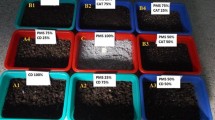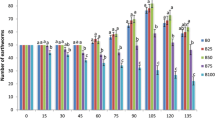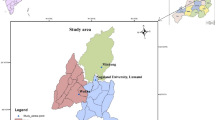Abstract
Purpose
Huge quantity of paper mill wastes are dumped at the outskirt of factory as unwanted materials. Vermicomposting is an eco-friendly technique for beneficial conversion of different biodegradable/organic wastes into useful organic manure utilizing earthworms. Solid wastes generated in paper mills contain appreciable quantity of organic matter. Attempt was made for bio-conversion of Emami paper mill wastes with different numbers of Eisenia fetida (5–30 earthworms/2 kg substrate) for studying its influence on vermi-conversing time and quality of prepared vermicompost.
Method
Vermicomposting was carried out in trays following heap method and quality of final product was determined following both chemical analysis and bioassay on wheat seedlings.
Results
Application of more earthworms up to 20 numbers per 2 kg substrate made bio-conversion quicker but further addition of earthworm, however, delayed the process as some earthworms came out of beds and died probably due to competition for food among earthworms inside beds. Ten earthworms per kg paper mill wastes–saw dust–cow dung mixture (1:0.5:0.5 weight wise) was found as optimum earthworm population for preparing quality vermicompost having more major and secondary plant nutrients. Bioassay of this manure on wheat seedlings also confirmed the analytical findings.
Conclusion
It is confirmed that earthworm population in vermibed played vital role in faster decomposition of paper mill wastes and releasing of more nutrients, which ultimately helped in better growth of wheat seedlings. Successful demonstration of vermicomposting technique will encourage local farmers for beneficial utilization of paper mill wastes in their agriculture.
Similar content being viewed by others
Avoid common mistakes on your manuscript.
Introduction
Direct use of paper mill solid wastes (PMW), generally collected from sewage line, on crop cultivation is not advisable as it hampers crop growth and pollutes both soil and underground water due to the presence of different toxic materials including heavy metals like lead, cadmium, mercury, etc., usually added during manufacturing of different types of paper as either ‘process aids’ or ‘product aids’(Ahirwar et al. 2015; Kumar and Chopra 2016). According to IPMA (2016) report, 70 percent paper mills in India use waste paper as a raw material for producing fresh paper. Emami paper mill at Balasore produces about 100 tons of paper everyday utilizing waste papers and a considerable quantity of paper mill waste as byproduct in Balasore, Odisha. de Andrde et al. (2019) has suggested economically and eco-friendly utilization of industrial landfill sludge by its amendment in soil instead of dumping in landfill due to high cost of landfills and loss of valuable plant nutrients essential for improved growth of sunflower and sorghum. Efforts were made earlier by different researchers for utilizing solid wastes of different paper mills either for producing porous bricks (Rajput et al. 2012) or using as cheap adsorbent materials for removing oil (Kok 1983), grease (Lowe et al. 1988), cellulose (Eifling and Ebbers 2006), etc. or to cover landfill as impermeable material (Zule et al. 2007), which would automatically avoid its detrimental effect on surrounding environment. Though PMW contains a good amount of organic matter, its bio-conversion using epigeic earthworms is not at all easy without some structural and nitrogen amendments due to its very high carbon nitrogen ratio, hardness when dry with less porosity and also due to the presence of different toxic materials (Sannigrahi 2018). Good quality vermicompost preparation depends on three important factors: nature of raw materials, types of vermi-bed preparation and earthworm population. Beneficial usage of saw dust and cow dung as structural amendments in PMW was shown earlier by Thyagarajan et al. (2010) in effective aerobic composting and Mohapatra et al. (2017a) in efficient vermicomposting. It was also noted that initial aerobic composting for 2 weeks with weekly twice turning of amended PMW (weight wise mixing of one part of PMW with half part of saw dust and half part of cow dung) not only enhanced the rate of vermicomposting but also helped to reduce the concentrations of different heavy metals in prepared vermicomposts (Mohapatra et al. 2018). Bed preparation by mixing together PMW, cow dung and saw dust was found very helpful in turnings of materials during aerobic composting, in producing better quality vermicomposts, in multiplication of juvenile earthworms and in better performance of paddy seedlings than bed preparations by layer wise placement of different raw materials (Mohapatra et al. 2017b). Earlier experiments on vermicomposting of agricultural wastes (grass and plant residues of tomato and French bean) using Perionyx excavatus earthworms (Sannigrahi 2004) and that of thatch grass (Imperata cylindrica) using both Perionyx excavates and Eisenia fetida earthworms (Sannigrahi 2005) proved that initial addition of more earthworms in vermicomposting beds made the vermicomposting quicker by decreasing the period of vermicomposting significantly. An attempt has been made in this experiment to determine optimum population strength of Eisenia fetida necessary for faster and efficient vermicomposting of wastes collected from Emami paper mill.
Materials and methods
Collection of PMW, saw dust, cow dung and earthworms
Paper mill wastes, saw dust and cow dung were collected from Emami paper mill, Remuna saw mill and farmer’s house at Balasore, respectively, before conducting this experiment. Healthy Eisenia fetida earthworms were collected from State Government Farm at Balia. The PMW had 7.65 pH, 3.0 dS/m electrical conductivity(EC), 1.14% total nitrogen, 0.24% total phosphorus, 0.65% total potassium, 12.0% total calcium, 0.15% total sulfur and 0.19% total sodium. Chemical analysis of collected saw dust and cow dung recorded pH 7.49 and 7.23, EC 0.4 dS/m and 0.8 dS/m, total nitrogen 0.89% and 0.35%, total phosphorus 0.48% and 0.29% and total potassium 0.54% and 0.38%, respectively.
Vermicomposting technique followed
Twenty-kilogram dried and powered PMW was mixed thoroughly with 10-kg saw dust and 10-kg cow dung. Fifteen moist beds were made in plastic rectangular trays by mixing 2 kg each of that mixture with required amount of water and kept under the cover of black plastic sheet for 2 weeks for initial aerobic composting. The bedding material of each tray was mixed weekly once with addition of water if necessary for maintaining the moisture of the bed at about 80–90%. After completion of two turnings of bed materials on 14 days, trays were arranged in randomized block design for five treatments and three replications. Eisenia fetida earthworms were released on top of each bed as per treatments (T1: 5 Nos., T2: 10 Nos., T3: 15 Nos., T4: 20 Nos. and T5: 30 Nos. earthworms per bed) and each tray was covered separately with moist hessian cloths. Moisture of beds was maintained at about 80% by spraying water, if necessary. After completion of composting, the black granular vermicompost of each tray was partially air-dried under shade. Earthworms, both adult and juvenile, were separated along with cocoons by hand sorting, counted and weighed in electronic balance. Vermicompost of each tray was sieved using 2 mm sieve and weight of both composted and non-composted portions was recorded.
Chemical analysis of vermicompost samples
These vermicomposts were analyzed following standard methods mentioned by Jackson (1973) and Tandon (2013) for pH (1:2), EC, oxidizable organic carbon (Walkley and Black titration method) and total nitrogen (Kjeldahl digestion and distillation method) while total phosphorous (Vanado-molybdate yellow color method), total sulfur (Turbidimetry method), total calcium (EDTA method) and total potassium and sodium (flame photometrically) were analyzed from diacid (9:4 mixtures of nitric acid and perchloric acid) digestion extract of each vermicompost. Calculation of each data was carried out on oven dry basis and presented with statistical standard deviation (SD) analysis.
Bio-assay of vermicomposts
Wheat seedlings were grown in plastic pots for studying the efficiency of prepared vermicomposts. Sixty pots (100-ml capacity) were filled up with each 48-g sands. Since there were 15 prepared vermicompost samples, 12 g of vermicompost of each sample was added in respective four pots denoting four replications. Treatment wise, all pots were arranged on experiment table in randomized block design. Fifteen healthy sonalika wheat seeds were sown in each pot. Deionised water was added to moist all beds. Seedlings were uprooted from pots after 25 days of seed germination for analysis of growth performance. After removing sands from roots by thorough washing and removing excess water in root by soaking on blotting paper, total fresh weight of seedlings grown in each pot was recorded in electronic balance. Length of shoots and roots was also measured over centimeter scale. Pot-wise dry weight of all seedlings was also recorded after keeping seedlings separately in paper packets for overnight drying at 100 °C.
Results and discussion
Impact on vermicomposting and production of vermicompost
The data on quantity of vermicomposts prepared, non-composted portions remained as left-out, period of harvesting, earthworm (both adults and juveniles) numbers, total weight of earthworms and cocoon numbers are presented in Table 1. Decrease in period of vermicomposting with increase in earthworm population up to 20 earthworms per bed or 10 earthworms per kg substrate was recorded probably due to faster completion of feed with more earthworms in comparatively lesser time. The result confirmed earlier findings of Sannigrahi (2004, 2005). Addition of more than 20 earthworms per bed, however, could not increase the rate of vermicomposting but it, on the contrary, took little more time to complete. It was noted that some earthworms went outside of those three trays and died probably due to competition for food created from over population of earthworms in beds, resulting ultimate delay in completion of vermicomposting. The less number of adult and juvenile/small earthworms along with cocoon numbers in treatment 5 confirmed this probability. About 0.78–1.08-kg vermicompost was harvested from 2-kg resource materials and about 26–28% remained as non-composted portion except treatment 4 where only 12% waste mixture remained as non-composted. The more quantity of vermicompost, less amount of non-composted substrate and availability of juvenile earthworms as well as cocoons in larger number proved that release of earthworms at the rate of 20 numbers per bed or 10 numbers per kg substrate is the most suitable earthworm population for vermicomposting of saw dust–cow dung amended Emami paper mill wastes.
Impact on nutrient status of vermicomposts
As summarized in Table 2, the pH of vermicomposts varied from 7.47 to 7.97, electrical conductivity (EC) from 2.43 to 3.06 dS/m, moisture percentage from 24.30 to 36.30% and oxidizable organic carbon from 9.26 to 14.33%. Slight variation in results was obviously due to earthworm activity only since composition of substrates was same in all treatments. The trend of pH and organic carbon was in agreement with earlier findings of Sannigrahi (2004).
Total nitrogen in vermicomposts gradually increased from 0.89 to 1.27% with addition of more earthworms in beds (Table 3). Role of earthworms in improving nitrogen content in vermicompost was also reported earlier by Senapati and Dash (1984), Bhatnagar and Palta (1996), Venkataratnam (1998), Sannigrahi and Chakrabortty (2000), which was mainly due to loss of organic carbon during decomposition, production of mucus as well as nitrogenous excrements by earthworms and increasing the population of nitrogen fixing microorganisms by earthworms. No significant variation in total phosphorus (0.26–0.29%) and potassium (0.77–0.84%) contents was recorded among treatments since the composition of substrates was same in all treatments. Almost similar quantities of phosphorus and potassium in vermicomposts of Emami paper mill solid wastes were recorded in other experiments by (Mohapatra et al. 2017b, 2018). Comparatively, higher nutrient status in vermicomposts prepared from treatment T4 confirmed the beneficial role of optimum earthworm populations. The result was in agreement with earlier findings of Sannigrahi (2004, 2005).
Table 4 presents the status of secondary nutrients especially total calcium, sulfur and sodium, that varied from 10.74 to 12.42%, 0.22 to 0.27% and 0.34 to 0.38%, respectively, confirming earlier findings of (Mohapatra et al. 2017b, 2018). More earthworm activity had resulted slight increase in calcium and sulfur content but opposite trend in sodium content. Earthworms probably helped to release more calcium and sulfur from PMW and to remove by adsorption some dynamic sodium from prepared vermicomposts.
Bioassay of vermicomposts
The growth parameters of wheat seedlings grown in different vermicompost samples prepared under influence of varying earthworm population showed that shoot and root lengths as well as average weight of fresh and dry plants were highest in treatment T4 than other treatments (Table 5). The better performance was obviously for comparatively better nutrient status of vermicomposts in treatment T4 as found from their chemical analysis. The plants in T4 were seen strong and long with better root pattern as compared to others.
Demonstration of successful vermicomposting technique among local farmers will help them in conversion of paper mill solid waste into good-quality vermicompost for its use in their own agriculture. This will reduce both soil pollution as well as conflicts between local farmers and mill owner due to unwanted dumping of paper mill wastes. Bonoli et al. (2019) reported that composting of organic wastes by local farmers not only solved the disposal problem of organic wastes but also economically encouraged by assuring guarantee of self production of fertilizer useful for their own agricultural cultivation.
Conclusion
The experiment, therefore, showed that earthworm population in vermibed played a vital role not only in vermicomposting of paper mill wastes but also in the decomposition of organic matter, in improving nutrients status and ultimately in enhancing crop growth. Twenty earthworms per 2 kg PMW–SD–CD (1:0.5:0.5) mixture was found optimum earthworm population essential for faster completion of vermicomposting. The experiment has proved that further addition of earthworm population may hamper the bio-conversion process of paper mill wastes.
References
Ahirwar MK, Gupta GS, Kirar N, Ahirwar P (2015) Monitoring of heavy metals in effluent of Orient paper mill, Amlai (Shahdol), MP. Int J Chem Stud 3(4):6–9
Bhatnagar RK, Palta RK (1996) Earthworm—Vermiculture and vermicomposting. Kalyani Publishers, New Delhi, pp 6–49
Bonoli A, Zanni S, Awere E (2019) Organic waste composting and sustainability in low-income communities in Palestine: lessons from a pilot project in the village of Al Jalameh, Jenin. Int J Recycl Org Waste Agric. https://doi.org/10.1007/s40093-019-0264-8
de Andrde LC, Andreazza R, de Oliveira Camargo FA (2019) Cultivation of sorghum and sunflower in soils with amendment of sludge from industrial landfill. Int J Recycl Org Waste Agric 8:119. https://doi.org/10.1007/s40093-018-0236-4
Eifling RB, Ebbers HJ (2006) Cellulose absorbent. US Patent 7038104 B1
IPMA (2016) Paper Industry Statistics. Indian Paper Manufacturers Association. http://ipma.co.in/paper-industry/production-trends. Accessed 26 June 2017
Jackson ML (1973) Soil chemical analysis. Prentice-Hall, New Delhi
Kok JM (1983) Process for the preparation of a liquid absorbing and shock absorbing material. US Patent 4374794
Kumar V, Chopra AK (2016) Reduction of pollution load of paper mill effluent by phytoremediation technique using water caltrop (Trapa natans L.). Cogent Environ Sci 2:1153216. https://doi.org/10.1080/23311483.2016.1153216
Lowe HE, Yoder LR, Clayton CN (1988) Non-clay oil and grease absorbent. US Patent 4734393
Mohapatra D, Sahoo KK, Sannigrahi AK (2017a) Impact of structural amendment of paper mill wastes with different organic materials on vermicomposting using Eisenia fetida earthworms. J Environ Waste Manag 4(1):53–63 http://www.premierpublishers.org. Accessed 29 Mar 2018
Mohapatra D, Sahoo KK, Sannigrahi AK (2017b) Impact of bed preparation techniques with different substrates on vermicomposting of paper mill wastes. CIB Tech J Biotechnol 6(2):1–9 http://www.cibtech.org/cjb.htm. Accessed 16 Apr 2018
Mohapatra D, Sahoo KK, Sannigrahi AK (2018) Influence of initial aerobic decomposition on vermicomposting of paper mill wastes amended with saw dust and cow dung. Int J Waste Resour 8(1):325–330. https://doi.org/10.4172/2252-5211.1000325
Rajput D, Bhagade SS, Raut SP, Ralegaonkar RV, Mandavgane SA (2012) Reuse of cotton and recycle paper mill waste as building material. Constr Build Mater 34:470–475. https://doi.org/10.1016/j.conbuildmat.2012.02.035
Sannigrahi AK (2004) Comparative performance of earthworm population and cow dung waste ratio on vermicomposting. Mysore J Agric Sci 38(3):410–412
Sannigrahi AK (2005) Efficiency of Perionyx excavatus in vermicomposting of thatch grass (Imperata cylindrica) in comparison to Eisenia foetida in Assam. J Indian Soc Soil Sci 53(2):237–239
Sannigrahi AK (2018) Management of hazardous paper mill wastes for sustainable agriculture. In: Hussain CM (ed) Handbook of environmental materials management. Springer, New York, pp 1–23. https://doi.org/10.1007/978-3-319-58538-3_12-1
Sannigrahi AK, Chakrabortty S (2000) Impact of composting techniques on the availability of NPK and microbial population in composts. Environ Ecol 18(4):888–890
Senapati BK, Dash MC (1984) Functional role of earthworms in decomposer subsystem. Trop Ecol 25:54–73
Tandon HLS (2013) Methods of analysis of soils, plants, water, fertilizers and organic manures. FDCO Publication, New Delhi
Thyagarajan LP, Meenambal T, Mangaleshwaran L, Lakshminarasimaiah N, Ramesh N (2010) Recycling of pulp and paper industry sludge with sawdust by aerobic composting method. Nat Environ Pollut Technol 9(1):149–154
Venkataratnam L (1998) Vermiculture: a profitable new agri-business. Health Action 11(3):32–33
Zule J, Černec F, Likon M (2007) Chemical properties and biodegradability of waste paper mill sludge to be used for landfill covering. Waste Manag Res 6(25):538–546
Acknowledgements
The first author is thankful to the Principal, FM (A) College, Balasore for extending laboratory facility to carry out her research work. She also expresses her sincere gratitude to the Vice Chancellor, Fakir Mohan University, the Dean, PG Council, the Controller of Examination and the Head, Department of Environment Science for providing necessary permission to carry out her research work leading to Ph. D.
Author information
Authors and Affiliations
Corresponding author
Additional information
Publisher's Note
Springer Nature remains neutral with regard to jurisdictional claims in published maps and institutional affiliations.
Rights and permissions
Open Access This article is distributed under the terms of the Creative Commons Attribution 4.0 International License (http://creativecommons.org/licenses/by/4.0/), which permits unrestricted use, distribution, and reproduction in any medium, provided you give appropriate credit to the original author(s) and the source, provide a link to the Creative Commons license, and indicate if changes were made.
About this article
Cite this article
Mohapatra, D., Sahoo, K.K. & Sannigrahi, A.K. Impact of Eisenia fetida populations on bio-conversion of paper mill solid wastes. Int J Recycl Org Waste Agricult 8 (Suppl 1), 189–193 (2019). https://doi.org/10.1007/s40093-019-0288-0
Received:
Accepted:
Published:
Issue Date:
DOI: https://doi.org/10.1007/s40093-019-0288-0




